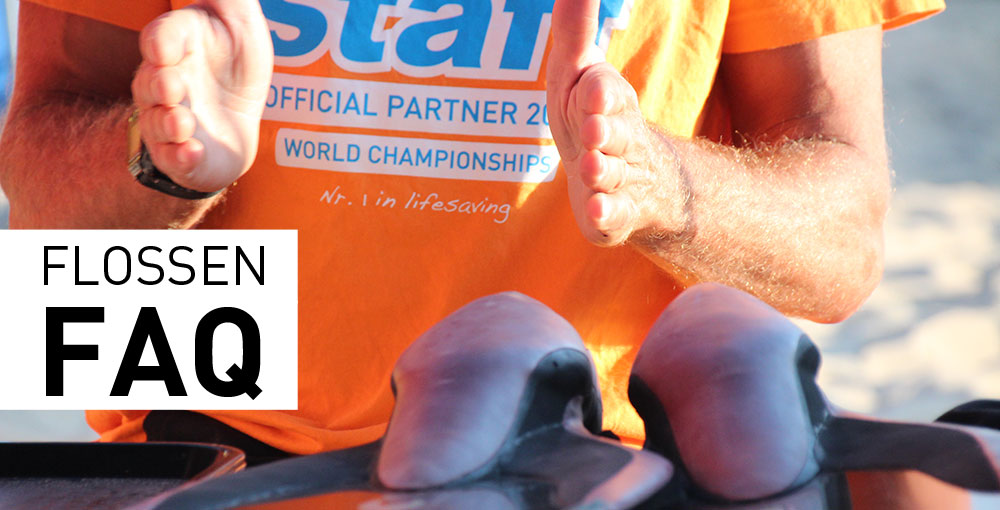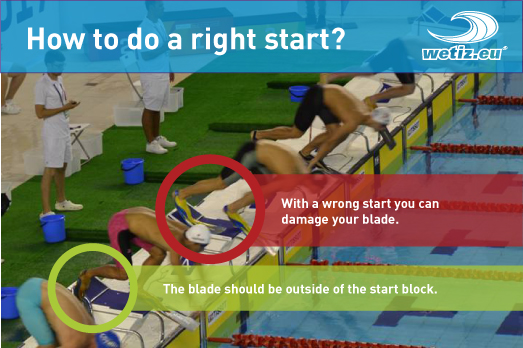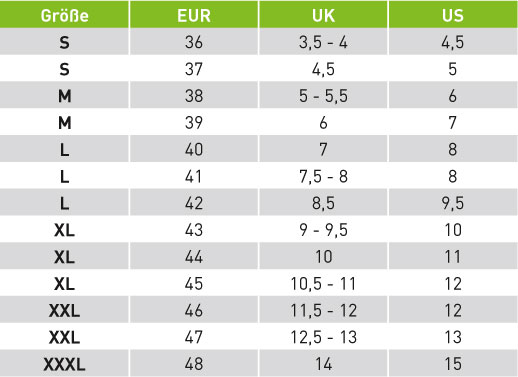Fins FAQ - All about the fins!
1. Why does delivery take about 7 weeks?
Each fin is manufactured by hand in a time-consuming process. Due to the complexity of the production process and our exacting quality requirements, we are not able to reduce the time taken for manufacture.
Please note: The production is closed around christmas and eastern. Here you can add approx. 2 more weeks.
2. How can I extend the lifespan of my fins?
The fins should always be rinsed in fresh water after use. (Not chlorinated or sea water and no soap or detergent.) They should ideally be stored in a dark room or in a light-proof bag (due to the use of rubber parts). If you are taking a longer break from training (several months or more), it is advisable to apply talcum powder to the rubber parts.
3. How do I prevent damage to the front part of the blade?
Unfortunately we have had quite a few cases where users have complained about damage to the front part of the fin blade. This is due to swimming pools in which the edge of the pool is at water level.

Certain points on the tip of the fins hit the starting block during turns, and this impact places a lot of strain on the fibreglass. It is therefore important to ensure that you strike the pool edge slightly to the side of the lane (so that the fin does not strike the starting block) or that you push off from the pool edge more gently.
4. Do I fin socks ?
Using fin socks is particularly advisable if you have narrow feet. However, to ensure an excellent fit, especially in competition, we recommend using half socks with all models.
5. Which fin size is right for me?
It’s difficult to generalise, as all feet are different, e.g. you may have a high instep, wide feet, flat feet, narrow feet, etc.
Putting your fins on should, however, be a little difficult. To ensure that the fins hold your feet well, they need to be tight. It is therefore helpful to use the measurement chart. (You may wish to order a slightly larger size if you have a high instep or wide feet, or a slightly smaller size if you have very narrow feet).
Determine your shoe size - The Step by Step Guide!

6. Soft, medium or hard? Our recommendation.
The vast majority (almost 80%) of athletes swim in medium fins, around 20% in soft and only about 3% in hard. Hard fins are rarely used for distances greater than 50 m. For 100 m swims, especially when carrying a manikin, experience shows that there is too much lactic acid build-up in the legs over the last 20–30 m.
7. What do I need to think about in terms of fin width? ?
The wider the fins, the greater the risk that you will be unable to keep your upper body still and will lose speed as a result.
Recommendations for girls:
Girls generally tend to use a soft fin with a maximum blade width of 23 cm. But here again, there is no hard and fast rule. Depending on the swimmer’s musculature, either a soft or medium fin might be recommended.
Recommendations for boys:
Because of the position of their hips and leg musculature, boys tend to use a slightly wider fin (25/26 cm). The hardness also tends more towards medium (at least for 100 m distances). They may require slightly softer fins for the 200 m super lifesaver event or open water use.
Hard fins are used for 50 m distances or by athletes with good, strong leg muscles.
In general, it should be noted that, when testing fins (borrowed from team-mates or at test events), you should always swim the actual race distance, as harder fins in particular are faster for the first 50 metres, but thereafter have such a fatiguing effect on the legs that swimmers subsequently end up losing all of the time they have gained over that first 50 metres.
8. Which fins are approved for competition?
Maximum permissible fin dimensions are 30 x 65 cm. All of the fins we sell are approved for competition.
9. The edge protection on the fins is coming off. Do I need to replace the fins ?
No, you don’t need to replace them. A small repair taking about 20 minutes is all you need to get your fins back in shape. New edge protection for 1 pair of fins can be found here: https://wetiz.eu/de/extras/1095-kantenschutz-reparatur-gummi.html
Step by step – rubber to fibreglass
(Edge protection to fin blade and foot pocket to fin blade)
What materials do I need?
– instant adhesive (Loctite 406, Delo-Ca, cyanoacrylate glue)
– sandpaper
Step 1:
Gently sand both sides of the area where the edge protection is coming off.
Step 2: Clean the sanded area (with e.g. turpentine or ethanol)
Step 3: Apply the glue, leave to dry slightly for about 5–10 minutes, press firmly together and you’re done.
Step by step – rubber to rubber
What materials do I need?
– vulcanising solution (as used for bicycle puncture repairs)
– sandpaper
Step 1: Gently sand both sides of the area where the edge protection is coming off.
Step 2: Clean the sanded area (with e.g. turpentine or ethanol).
Step 3: Apply the glue, leave to dry slightly for about 5–10 minutes, then press a bicycle tyre patch firmly onto the sanded area, and you’re done.
10. There is a tear in the blade. What can I do?
Here is the best and simplest solution, gleaned from many years of competition experience.
Drill the smallest hole possible at the end of the tear and apply some tape or a waterproof sticker. (We have found that it is not a good idea to repair the area with fibreglass, as this area will then break again, as it does not have the same hardness as the rest of the blade.) For tears of up to 4 cm, following the sticker version of the above instructions has proved to be very successful. This type of damage (in the front third of the fin only of course) does not appear to lead to any loss of speed.